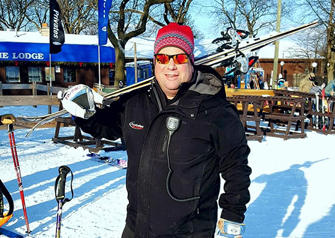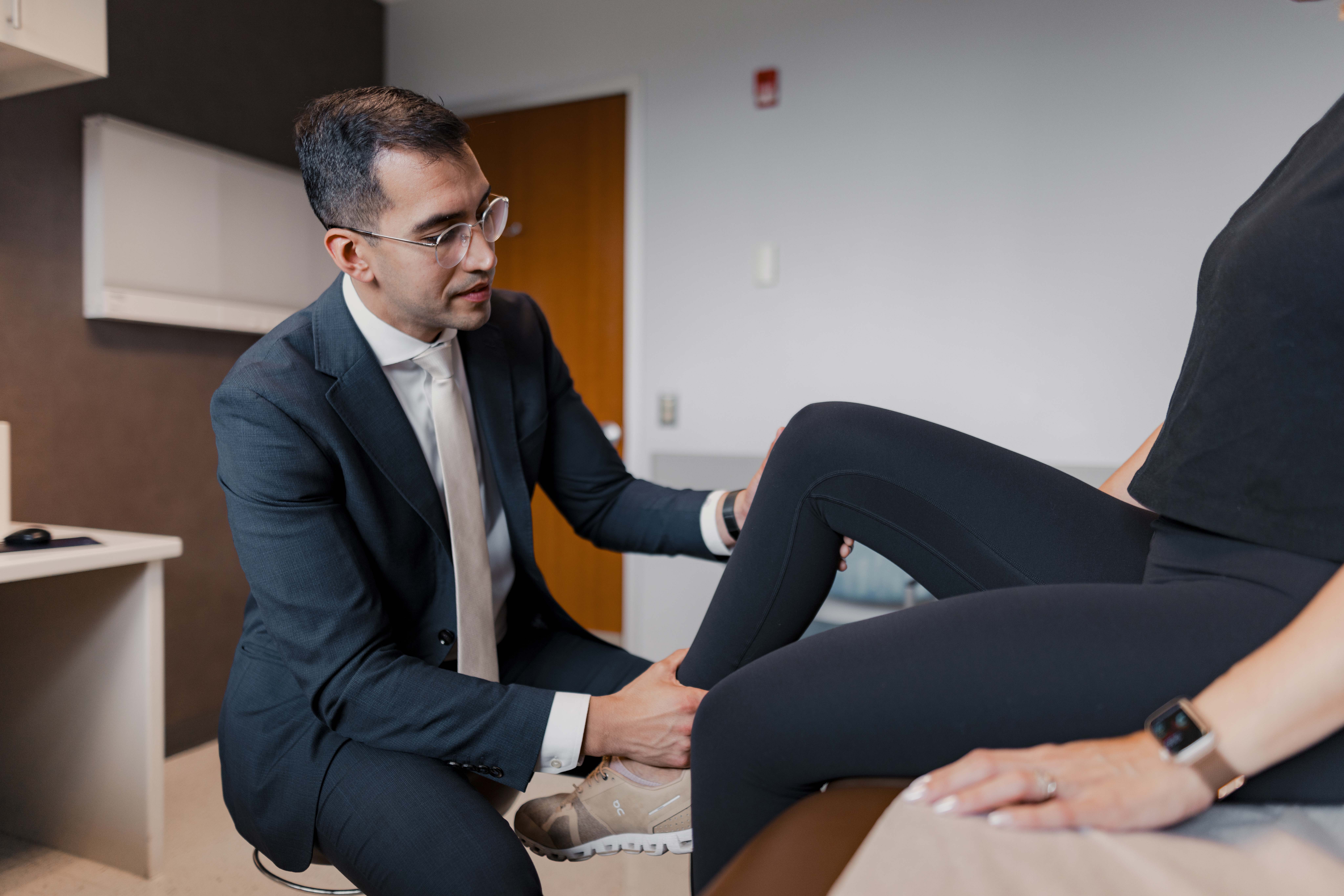
News
Patients Share Ski and Snowboard Advice
Date posted: 2/18/2021
Last updated: 2/18/2021
Table of Contents
February 18, 2021
At Midwest Orthopaedics at Rush, we love ski and snowboard season, but professionally, it can be a very busy time. We treat many snow sport-related injuries such as shoulder dislocation, rotator cuff tear, collarbone fracture, ACL, MCL, and meniscal tears, wrist fracture, back injury, and concussion. Typically, our patients are able to return to their sport.
Recently, we spoke with some patients who wanted to share their wisdom from recent ski or snowboard injuries to help others avoid the same outcomes.
Michael Scatena, 25, Palos Park, Ill.
A snowboarder since age 14, Scatena wasn’t concerned when he headed to Alpine Valley, WI after a three-year break from the sport. And, he had a great day — until the last run.
“Something caught my board, and I flew forward,” he says. “I landed on my left shoulder. It was a direct impact, and I knew right away something bad happened.”
He was right. Once home, he visited a local orthopedic surgeon who diagnosed him with a Grade 5 (out of 6) acromioclavicular (AC) joint separation. This meant that his clavicle (collar bone) has become separated from his scapula (shoulder blade). This physician recommended conservative treatment, no surgery.
“I didn’t want any problems going forward so I went for a second opinion,” he says. After doing some research, he discovered shoulder specialist Dr. Grant Garrigues who strongly disagreed with the first treatment plan and recommend surgery right away to reconnect and stabilize his shoulder joint.
“For a Grade 5 AC separation in a young, athletic person, there is a window of opportunity where we can operate and get the patient back to full activity without having to reconstruct the torn ligaments,” notes Dr. Garrigues. “I was glad we were able to get his shoulder realigned and stabilized quickly—he has an excellent prognosis.”
Nearly recovered now, Scatena feels he will soon be ready to get back up on a mountain. His advice to others is, “Watch your speed and always wear a helmet because that is the body part that is hardest to fix.”
Drew Johnson, 24, Chicago, Ill.
Just recently, Johnson, who grew up skiing and snowboarding in the mountains outside Denver, was unconcerned about trying out a midwestern ski resort for the first time. After all, how hard could Boyne Mountain, MI be compared to Colorado?
He quickly found out the difference between a nice powder and an icy surface.
“I went off a kicker, which is a kind of jump ramp, and landed on my left shoulder,” Johnson explains. “It felt like glass shattering in my body.”
After ski patrol was called and carried him down the hill, he saw a local orthopedic physician who identified four fractures in his clavicle. The doctor didn’t think surgery would be necessary, but Johnson wanted to be sure.
Before he even got home, he researched top-rated sports medicine and shoulder specialists in Chicago and scheduled an appointment with Dr. Nik Verma. Dr. Verma talked with Johnson, reviewed his x-rays, and explained why he recommended surgery to return him to full function.
“Drew had a complex fracture of his clavicle (collarbone) - it was in multiple pieces and the bones were misaligned,” explains Dr. Verma. “In this case, there can be a higher rate of the bone not healing and when it does heal, can create a deformity that impedes shoulder function. As a result, we fixed his clavicle with a plate and screws which allowed me to restore his normal alignment. Because the fracture was fixed, the pain got better quickly, and he returned to activities sooner.”
“The surgery and recovery weren’t bad,” explains Johnson. “I was worried about being able to do my job, but I only had to take a week off.”
Johnson “absolutely” will return to snowboarding and offers this advice: “If you’re not falling, you aren’t risking it. But, at some point, you have to decide when it’s not worth it anymore.”
Thomas Gebhardt, 24, Chicago, Ill.
Gebhardt also grew up skiing in Colorado and as a lacrosse player and golfer, was no stranger to sports injuries. “I’ve had wrist, rib, and shoulder injuries but it is the concussions that scared me the most,” he says.
Early this year, Gebhardt was skiing in Colorado with friends when he experienced his third ski-related concussion and his 5th overall. “Gravity is a powerful force, and you are going to lose,” Gebhardt explains. “I was attempting a 360 jump and my ski got caught on something. When I fell, I landed on my ribs and head.”
His friends gathered around to offer support but Gebhardt shook it off. He skied the rest of the way down the hill. “I didn’t want to ruin everyone else’s fun,” he explains.
He entered what he calls ‘adrenalin shock mode’ and continued skiing after a short break. Eventually, he called it a day and went home. The next day, he awoke with classic concussion symptoms: headache, blurred vision, mental fog, anxiety, and difficulty communicating clearly. When these symptoms didn’t resolve after three days, he went to an emergency department in
Colorado where he was given strict concussion protocol, including taking time off, moderate exercise, heightened attention to symptoms, and limited use of screens. The Colorado physician also recommended he follow up with Dr. Elizabeth Pieroth, Director of the Concussion Program at Midwest Orthopaedics at Rush.
When he returned to Chicago, he met with Dr. Pieroth who gave him a thorough evaluation and adjusted his post-injury treatment. She explained the serious nature of multiple concussions.
“In a case like Thomas', it is important to have a discussion with a concussion specialist to examine the patient's history of concussions and review the risks/benefits of engaging in any high-risk activities," Dr. Pieroth explains.
Gebhardt does plan to ski again but will follow his own advice: “Next time I will know my boundaries and won’t push them. If I jump again, I will take smaller, smarter risks. And, if I ever fall again, I will assume I am injured and will not push through.”
Anthony Ford, 52, Joliet, Ill.
An expert skier, Ford has been teaching skiers for 35 years, including his three kids, all of whom competed in downhill racing. Along the way, he sustained some ski injuries, but nothing prepared him for one in particular.
Several years ago, Ford was enjoying a steep run at Arapahoe Basin in Colorado. He remembers clearly that it had a 40-degree incline and was full of trees. “I was doing fine and then my left knee just collapsed,” he says. “I tumbled about 50 yards, hit trees along the way and my left ski didn’t release.”
He became jammed against some trees and felt he shouldn’t try to move. Friends skiing with him called ski patrol and Ford was immediately airlifted to a local hospital. It was there that doctors discovered Ford had sustained life-threatening arterial damage and compartment syndrome (dangerous pressure built up in the leg) and needed emergency vascular surgery. He also had severe ligament injuries which were put on hold until the arterial surgery was completed.
“Never in my wildest imagination did I think I would get that hurt,” Ford says. “I was told it was questionable whether or not they could save my leg.”
After a month-long stay in a Colorado hospital, he was able to return home to seek the best knee physician to repair his torn ligaments. He discovered Dr. Adam Yanke, a specialist in complex knee conditions, who surveyed the damage to Ford’s knee.
“He had a complete knee blow-out,” Dr. Yanke says. “He tore his patellar tendon, MCL, ACL, PCL, and LCL. That’s all the ligaments there are in the knee joint.” Dr. Yanke first repaired Ford’s patellar tendon to stabilize the knee cap. Then, in a second surgery, he repaired the four torn ligaments with cadaver tissue. Following two successful surgeries, he had high hopes for Ford’s return to normal activity, which might one day include skiing.
And return he did. Just one-year post-surgery, Ford skied in Colorado again. “Today, I’m pretty darn close to my former ability and I’m so grateful to Dr. Yanke for putting my knee back together.”
Ford’s advice to skiers is: “Be in tune with your body and don’t ever push past your limits.”


